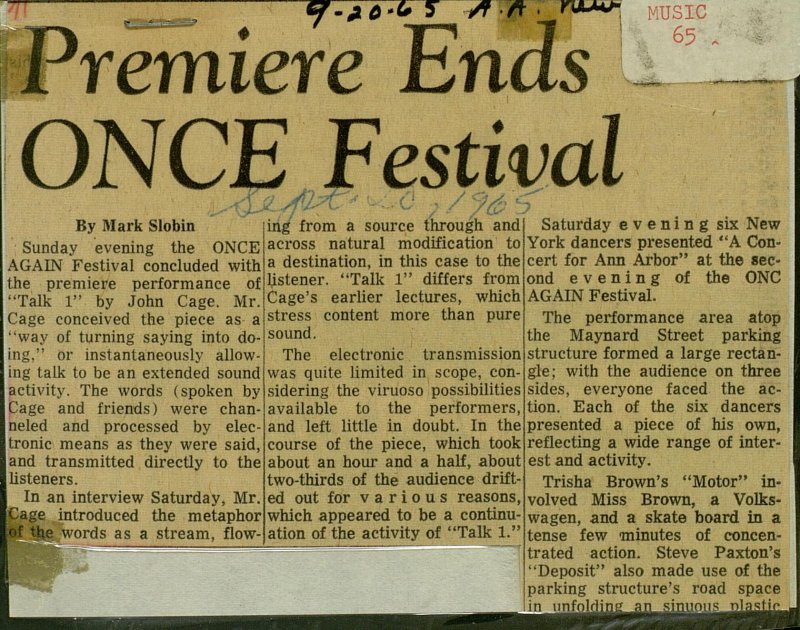Tune In Before Select Renegade Performances
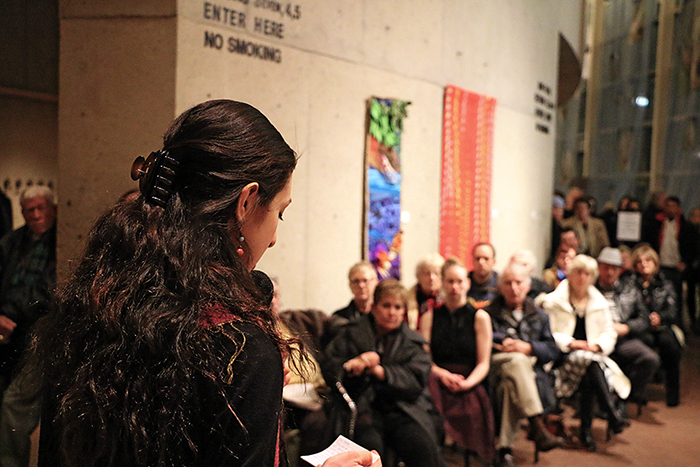 21st Century Artist Intern Hillary Kooistra gives a pre-show Tune In for Trisha Brown Dance Company’s performance February 21, 2015.
21st Century Artist Intern Hillary Kooistra gives a pre-show Tune In for Trisha Brown Dance Company’s performance February 21, 2015.
Tune In with UMS for a brief pre-performance talk before select Renegade series performances; the next Tune In is before Bill Frisell’s solo performance on 3/12. Just 15 minutes long, each Tune In offers interesting information and provocative questions for thinking about, listening to, and watching the performance. The Renegade series celebrates artistic innovation, experimentation, and discovery.
Trisha Brown’s “Motor” at 1965 ONCE Festival
50 years ago choreographer Trisha Brown revved things up with “Motor,” a choreographic work for Volkswagen Beetles that had its world premiere in Ann Arbor’s Maynard Street parking garage. Check out more about this Ann Arbor News clipping: http://bit.ly/1vKHDg0
Did you go see Trisha Brown Dance Company’s performances 2/21-22? What did you think?: http://bit.ly/1A1FhKt
Artist Interview: Jamie Scott, Trisha Brown Dance Company Dancer
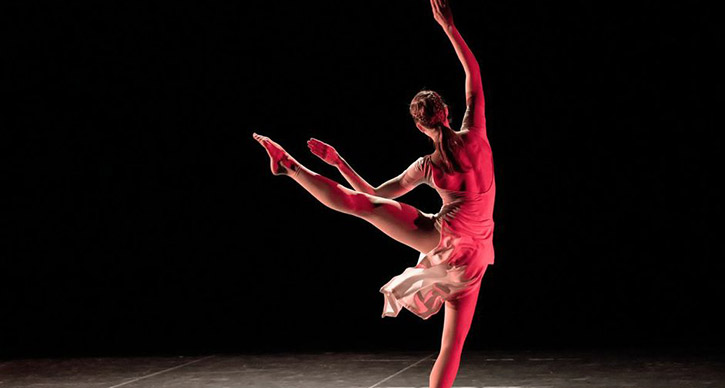
Photo: Trisha Brown Dance Company dancer Jamie Scott performs “If You Couldn’t See Me.” Photo by Alice Gebura.
The Trisha Brown Dance Company performs in Ann Arbor on February 21-22, 2015. Hillary Kooistra, University of Michigan Dance student and UMS intern, spent five weeks with the company during Summer 2014 as part of a new internship program. During her internship, Hillary had the chance to work with the company, and also to sit down with company members and interview them.
Her first was with dancer Jamie Scott. Jamie started dancing with the company as an apprentice in February 2012.
Hillary Kooistra: You’ve actually performed at UMS before with the iconic Merce Cunningham Dance Company. How has your work with the Trisha Brown Dance Company (TBDC) compared to your experience with Merce Cunningham?
Jamie Scott: It’s a very different way of approaching movement for me. A lot of the work that I’ve been doing since I joined TBDC has been re-calibrating the way that I think about movement, the way that I see movement, and the values that I give to different types of movement. There are many similarities, too, with learning repertory that’s been done before and with finding a way to re-inhabit works that have been done.
HK: Aesthetically, what would you say are some of the differences between Trisha’s work and Merce’s work?
JS: They strike a very similar aesthetic or taste from my point of view. But I’d say the biggest difference is that Merce’s work is very externally driven. The movement is very inorganic, and the task is finding a way to do the impossible, to use your muscles and everything you have to make these tasks possible. With Trisha, it’s almost the opposite. There are equally impossible tasks, but I’m trying to strip away as much as I can and re-calibrate force and energy. To find a way to arrive at the impossible form the inside out, rather than the outside in.
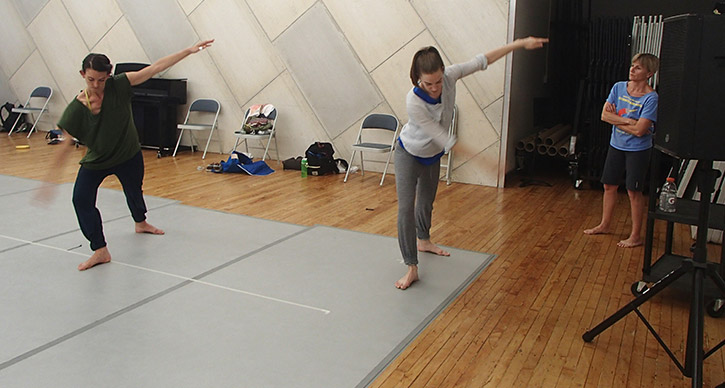
Photo: Jamie and Cecily Campbell (who shares the soloist role in “If You Couldn’t See Me”) rehearse part of the solo with Associate Artistic Director Diane Madden. Photo by Hillary Kooistra.
HK: At Power Center, you’ll perform Trisha Brown’s solo “If You Couldn’t See Me.” I know that you didn’t get to work directly with Trisha Brown in the studio, so how did you prepare, learn, and embody her movement for this solo?
JS: Leah Morrison, another dancer who has performed this solo, taught it to me along with Carolyn Lucas, one of the associate artistic directors of the company. After Leah left the company, we sat down with this amazing archive of footage of Trisha when she was first making the solo. In the video, she is going through the process of creating the movement, just so, and then taking it a step further, and then paring it back. We kind of went along with her whole process, and in doing that we got a lot of physical information that then translated into what you’ll see on the stage.
HK: I’ve noticed that the company often rehearses without music. When you do put on the music, what is that extra layer like?
JS: Actually, working with Merce Cunningham was similar in that respect. We never rehearsed to music, so I’ve gotten used to that. It’s sort of on and off, on and off. But I remember that the first time that I performed to music after rehearsing in silence, it added another dimension in the space. It opened up my awareness, my perception of the space, and gave me something else to interact with. Very tangible, actually. Oddly enough, it seemed very tangible.
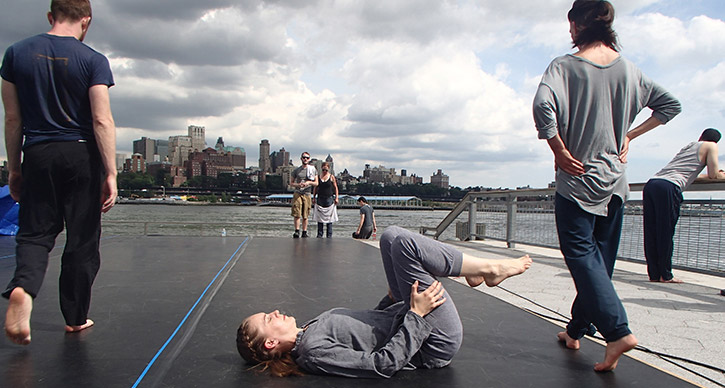
Photo: Jamie warms up before the Company’s performance of “I’m Going to Toss my Arms–If You Catch Them They’re Yours” at Pier 15 for the 2014 River To River Festival in New York City. Photo by Hillary Kooistra.
HK: What would you say is the most challenging aspect of Trisha Brown’s work?
JS: I would say that it’s being honest with movement and not embellishing, not exaggerating, but trusting the simplicity of it.
HK: Trisha’s known as one of the most iconic post-modern dancers and choreographers of our time, partially because of that quality of her movement vocabulary. Do you think that this term “post-modern” accurately characterizes her work?
JS: If we’re talking about stripping away the fluff, which is one of the big tenets of post-modernism in dance, really getting back to the human and getting rid of the fluff, this work continues to do that. This work is all about that, especially the earlier programs. The later work begins to explore, and as with any great artist, the trajectory goes somewhere else.
Read more of Hillary Kooistra’s behind-the-scenes coverage of Trisha Brown Dance Company.
Artist Interview: Leah Ives, Trisha Brown Dance Company Dancer
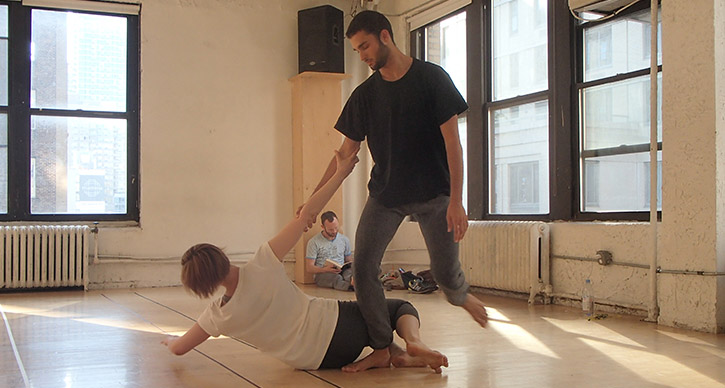
Photo: Trisha Brown Dance Company dancer Leah Ives and fellow dancer Marc Crousillat rehearse a duet from one of many pieces of repertory the two must learn as new members of the Company. Photo by Hillary Kooistra.
The Trisha Brown Dance Company performs in Ann Arbor on February 21-22, 2015. Hillary Kooistra, University of Michigan Dance student and UMS intern, spent five weeks with the company during Summer 2014 as part of a new internship program. During her internship, Hillary had the chance to work with the company on the administrative side and to also sit down with company members and interview them.
Her second interview was with dancer Leah Ives. Leah started dancing with the company in June 2014, and she is also a U-M Dance graduate.
Hillary Kooistra: You’re one of the newer members of the company. Trisha Brown Dance Company is an iconic post-modern company that’s currently in a transition period, and this performance is part of a tour that showcases major stage works. What’s it like to enter rehearsals when the company is in a transition period?
Leah Ives: It’s hard for me to know what it was like for people to enter when the company was not in a transition period. I think we’re very focused on the performances that are coming up, and so in some ways, I imagine that the transition hasn’t fully affected the company quite yet. I feel lucky to be able to jump in and have the chance to perform these works.
I also recognize that this movement hasn’t had as much time to settle into my body and that I have a lot to learn when compared to the other dancers who may have performed these roles and who have had years with these movements and with the pieces settling onto them. I feel like I have a large task to complete in a very short period of time.
HK: Did you always know that you wanted to dance for Trisha Brown?
LI: I was always interested in the company. Once I studied the movement and the repertoire, I found it really satisfying and intriguing mentally. There is a lot of specificity, a lot of attention to detail, and then a lot of of abandoning of that and seeing where that goes in the body.
So yes, I was always interested in the company, but there’s a point when a dancer recognizes that she’s one of many that would love to work for a full-time company, and an iconic company like Trisha Brown Dance Company at that. So, I was content studying the work and getting what I could from the work as a technique, as movement. I am so thrilled to be one of the lucky people who get to actually perform the work.
HK: What are you most excited to share with our Ann Arbor audience? I know the company is doing “Newark” as well as “Set and Reset” (1983).
LI: I’m excited to show the sense of weight and peacefulness in the body that Trisha Brown’s movement is known for. The sort of physics that play through the body in her work may be very different from some of the work that has been presented recently at UMS. I think the pieces we’re performing are really dynamic works, really exciting works, very full of bodies, movement, and interplay between dancers. They’re very exciting pieces to watch.
HK: You graduated from the University of Michigan with a BFA in Dance in 2007. Can you think of work that you did as an undergraduate student at U-M that reminds you of the work you’re currently doing?
LI: While I was there, choreographer Alexandra Beller set a piece with us, and both the interaction between dancers and the grounded-ness of the movement was similar to Trisha Brown’s work. Choreographer Doug Varone also set a piece with us, and the sense of momentum in that piece was very similar to Trisha Brown’s work, the sense of feeling the weight of the arms and the swing through the body. I had also studied with former Trisha Brown Dance Company dancers during the summers and that has really helped me in performing these works.
HK: How is Trisha Browns’s work differed from other dance works that you’ve encountered in your career so far?
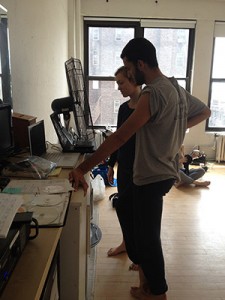
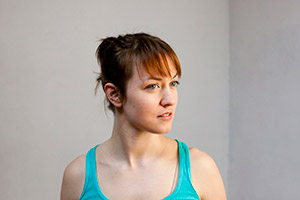
Photos: On left, Leah and fellow dancer Marc Crousillat review choreography from a DVD during some downtime in rehearsal. Photo by Hillary Kooistra. On right, Leah Ives. Photo courtesy of the artist.
LI: Trisha’s work is incredibly intricate in a way that I’ve not encountered very often. It’s very visual, the spacing between dancers is incredibly important. Trisha seemed to have a clear vision of what she wanted in each moment, so we are always trying to re-create that vision.
It’s a tricky process because we are looking at one version of that vision from when the work was originally created, and then maybe another version from ten years later and on a different stage and with different people. This process is very different from what I’ve done in the past.; my other projects have mostly been new works. This concept of taking these roles that were created by someone else and were modified through her body, put onto another body that may or may not have affected the role, and then taught to the person who is now teaching me, is a really interesting way of translating movement. It’s a great challenge. I’m not quite there in the rehearsal process yet.
HK: We’re really looking forward to seeing you on stage back in Ann Arbor! Before we end our chat, can you tell us about your most memorable UMS experience while you were at the University?
LI: The most memorable is hard to pick. I was fortunate enough to live fairly close to Ann Arbor growing up. I lived in Brighton, Michigan. So when I was in Middle School, we had a field trip to the Power Center to see Elizabeth Streb’s Dance Company. That was my first experience with modern dance. It was really exciting, especially at that age, to see people flying through space and their use of trampolines and technology (the soundtrack was based on the bouncing). That stuck with me for a long time.
Another experience that stuck with me was during the Royal Shakespeare Company residency. There were many programs beyond their performances, one of which included a competition of interpretations of a sonnet. I had made a dance based on a sonnet and got to perform it for Patrick Stewart. And I didn’t place, but it’s still something I can brag about! It was a great brag-worthy experience.
Read more of Hillary Kooistra’s behind-the-scenes coverage of Trisha Brown Dance Company.


